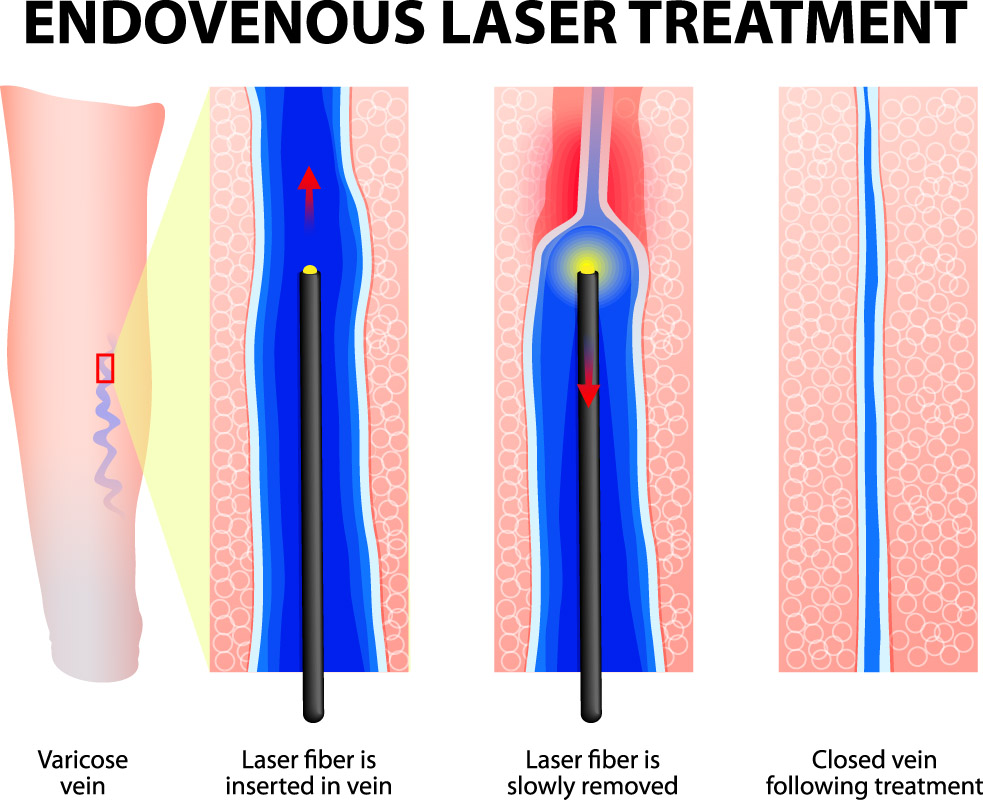Varicose Veins
What is vein disease?
Vein disease is a condition that can affect the veins in the legs. It can cause leg pain, varicose veins, swollen legs, or open sores. Varicose veins are swollen and twisted veins.
Vein disease happens when the veins in the legs do not work the right way. Normally, the veins in the legs carry blood from the legs back to the heart. The veins have tiny valves inside them to help keep blood moving in only one direction (toward the heart). The valves open to let blood flow to the heart, and close to keep it from flowing back down the leg. Vein disease can happen when the valves are damaged or do not work well. This causes blood to collect in the legs. Blood is especially likely to collect in the legs when a person sits or stands for a long time without walking.
Endovenous Laser Treatment
What conditions can cause vein disease? — Vein disease can be caused by:
- A blood clot in a leg vein
- Leg injury
- Being pregnant more than once – This causes a change in hormone levels that can weaken vein walls.
- Weight gain
- Vein disease also commonly runs in families.
What are the symptoms of vein disease? — People with vein disease can have symptoms that include:
- Leg pain, or the leg feeling tired or heavy
- Swollen veins – “Spider veins” are small leg veins that are swollen
- “Varicose veins” are larger leg veins that are swollen and twisted
- Swelling in the lower legs or ankles– People can have swelling at the end of the day or all the time.
- Skin colour changes – The skin can turn red or red-brown. Skin colour changes often happen first around the ankle.
- Itchiness or eczema in the lower leg with dry clay skin
- Open sores, also called “venous ulcers” – These are usually at the ankle and can be painful and ooze.
Is there a test for vein disease? — Yes. Our sonographers will do an exam to look at your legs. This test is called a duplex ultrasound. An ultrasound can check how well the valves in the legs work. It can also see if any of the veins in the legs are blocked.
What can I do to reduce my symptoms? — To reduce swelling, you can:
- Walk around, and try not to sit or stand in one place for a long time
- Raise your legs up 3 or 4 times a day, for 30 minutes each time
- Do exercises to point your toes and feet down and up a few times each day
To treat dry or itchy skin, you can:
- Use an unscented moisturizing cream. Ask your doctor or nurse before using any other type of cream or ointment, because some creams and ointments can cause a rash.
How is vein disease treated? — Different treatments are available to treat symptoms and reduce swelling. These can include:
- Special socks, bandages, or devices:
- “Compression stockings” are special socks that fit tightly over the ankle and leg. If your surgeon recommends that you wear them, he or she will tell you which type to wear and how to put them on
- “Compression bandages” are layers of bandages that wrap around a person’s leg.
- A “compression pump” is a device that fits around the leg and squeezes the leg every few minutes.
- Special dressings that are put on an open sore to help it heal
- Medicines – Doctors can use different types of medicines to treat different symptoms. For example, people with a skin infection might need antibiotics. People with itchy skin might need a prescription cream or ointment.
- Procedures – Doctors can do procedures if other treatments do not work. A doctor can remove or ablate damaged veins so they can no longer fill with blood.
What is vein ablation? — Vein ablation is a procedure that is used to treat different types of vein disease. It works by sealing up or removing a diseased vein, so that blood cannot flow through it anymore. The blood that would normally flow through that vein finds another route back to the heart. Vein ablation is done only to people who have not gotten better with simpler treatments. Vein ablation can be done a few different ways:
- Sclerotherapy – For this procedure, the doctor injects a chemical into the diseased vein that causes it to collapse on itself. The vein stays in place, but it no longer carries blood. Sclerotherapy is performed routinely onsite at VVC
- ENDOVENOUSLASER ablation (EVLA)– For these procedures, the doctor inserts a special wire into the diseased vein. This wire heats up the vein and seals it from the inside. The vein stays in place, but it no longer carries blood. These procedures involve no surgery and can be done with very little anesthesia. These procedures are performed routinely onsite at VVC
- Vein ligation or stripping – These procedures involve surgery to remove the diseased vein or veins. People who have these procedures must go under anaesthesia and be treated in a hospital or surgery center. Veins are removed through many small cuts.

